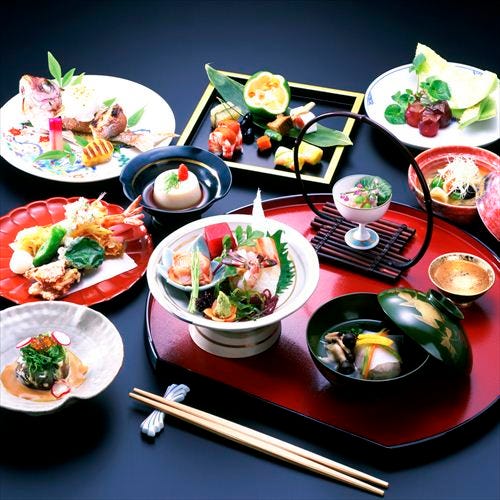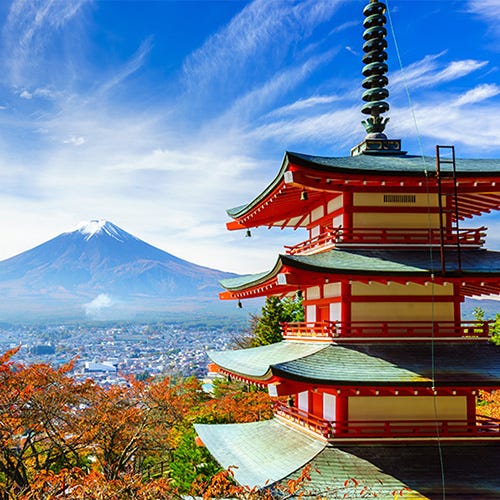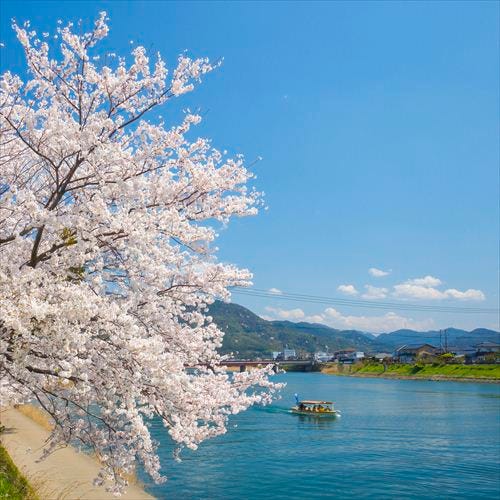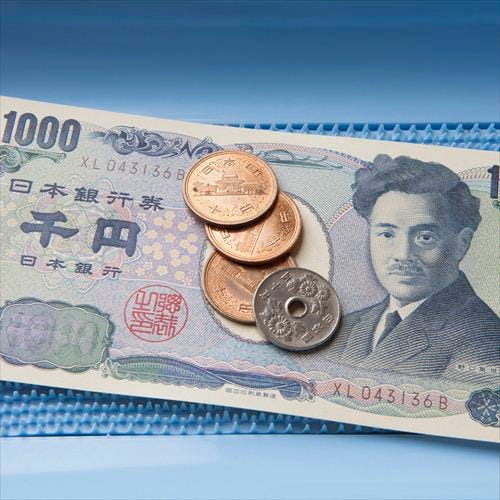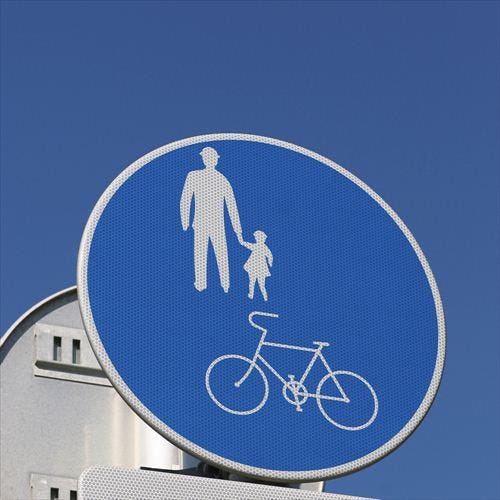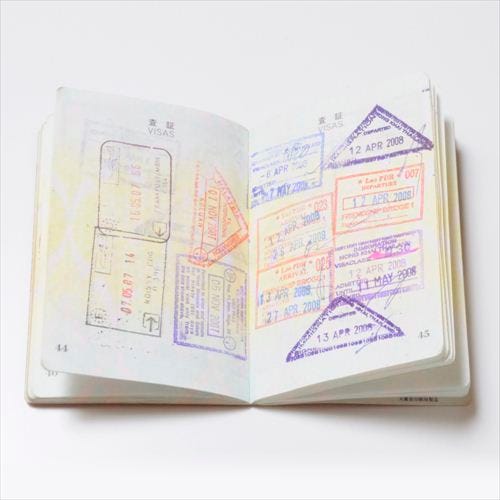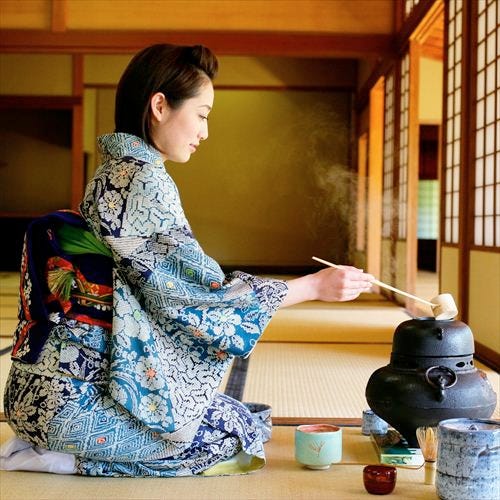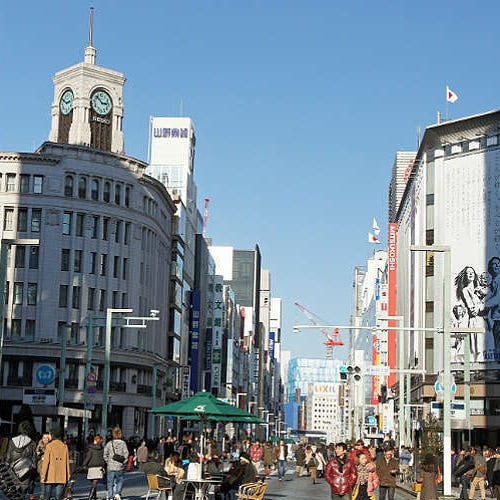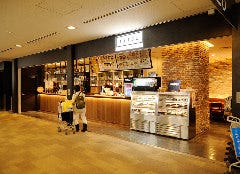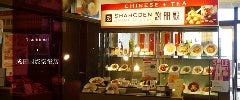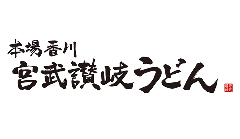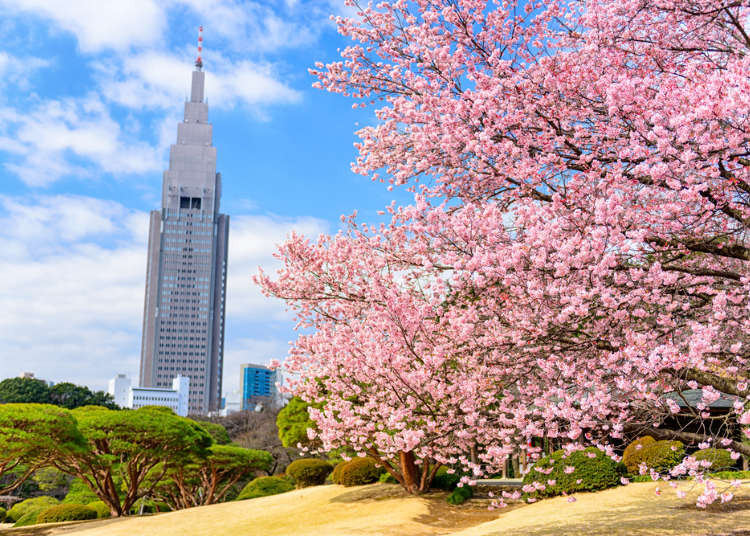
Discover Shinjuku Gyoen National Garden (新宿御苑), the natural oasis in the heart of Shinjuku! Immerse yourself in the breathtaking beauty of cherry blossoms in the spring, the stunning autumn foliage, and a variety of flora all year round. You'll feel like you've stepped into a whole new world!
Let's explore how to get to this amazing garden and what makes it so special.
- Please note prior reservations are required to enter Shinjuku Gyoen National Garden on specific dates during the cherry blossom viewing season. For more details, please visit the official website.
- Shinjuku Gyoen National Garden will introduce a "Children's Fast Track" at the Shinjuku Gate during peak cherry blossom season. It will be open to parents and guardians with children aged 15 and under on congested days, regardless of reservations. Congested days for 2023 are March 21, 25-26, 31, and April 1-2, 8-9.
- The information in this article is from January 2020 and updated in March 2023. Please check the official website for the latest details.
What is Shinjuku Gyoen?
Shinjuku Gyoen has a long history, beginning with it being the residence of Lord Naito, a vassal of Tokugawa Ieyasu. Later, it was used as an agricultural test site and was completed in May 1906 as an Imperial Garden.
In 1949, it was re-designated as a national garden and opened to the public. With the centennial anniversary of its opening in 2006, it has remained popular as an urban oasis.

How to get to Shinjuku Gyoen
Shinjuku Gyoen has three entrances that differ depending on where you enter: Shinjuku Gate, Okido Gate, and Sendagaya Gate.
Of these, the Shinjuku Gate is the primary entrance. It is located about a 10 to 15-minute walk from JR Shinjuku Station, and as it is used more than the other two entrances, it is considered the main entrance.
We recommend the following route from JR Shinjuku Station to Shinjuku Gyoen.
- Go out of the JR Shinjuku Station Southeast Exit.
- Using the escalator and elevator at the southeast exit of JR Shinjuku Station, go down to the plaza in front of the station.
- Cross over the street and go straight along the side of the girder bridge.
- Continue on to Koshu Kaido and then cross at the Shinjuku 4-chome intersection.
- Continue straight along the road, cross at the pedestrian crossing beyond the Sekaido, and then go over the pedestrian crossing on the right.
- After crossing the street, turn left and go straight.
- The Shinjuku Gate will be on your right, and the Information Center on your left.
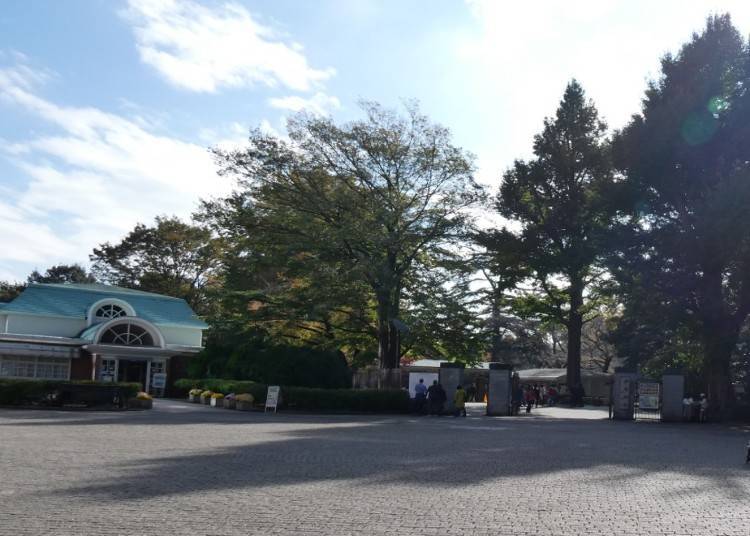
There are four train stations that you can use to get to Shinjuku Gyoen, and the walking times from each station are as follows:
1. Shinjuku Sanchome Station (Tokyo Metro Fukutoshin Line): Walk for 5 minutes from Exit E-5.
2. Seibu Shinjuku Station (Seibu Shinjuku Line): Walk for 15 minutes.
3. Shinjuku Gyoen-mae Station (Tokyo Metro Marunouchi Line): Walk for 5 minutes from the Shinjuku Gyoen-mae Exit.
4. Shinjuku Sanchome Station (Toei Shinjuku Line): Walk for 5 minutes from either C1 or C5.
Choose the station that's most convenient for you, and enjoy your visit to Shinjuku Gyoen!
By bus
To get to Shinjuku Gyoen by bus, you can use any of the following routes:
1. From Shinjuku Station West Exit: Board the Toei Bus Shina 97 going to the Shinagawa Garage and get off at the Shinjuku Sanchome bus stop.
2. From Shibuya Station East Exit: Board the Toei Bus Ike 80 going to Higashi Ikebukuro 4-chome and get off at the Shinjuku 4-chome bus stop.
3. From Shinjuku Station West Exit: Board the Toei Bus Haya 77 going to Waseda and get off at the Shinjuku Isetan-mae bus stop.
4. From any Shinjuku location: Board the Shinjuku WE Bus and get off at the Shinjuku Gyoen bus stop.
Getting to the Okido Entrance
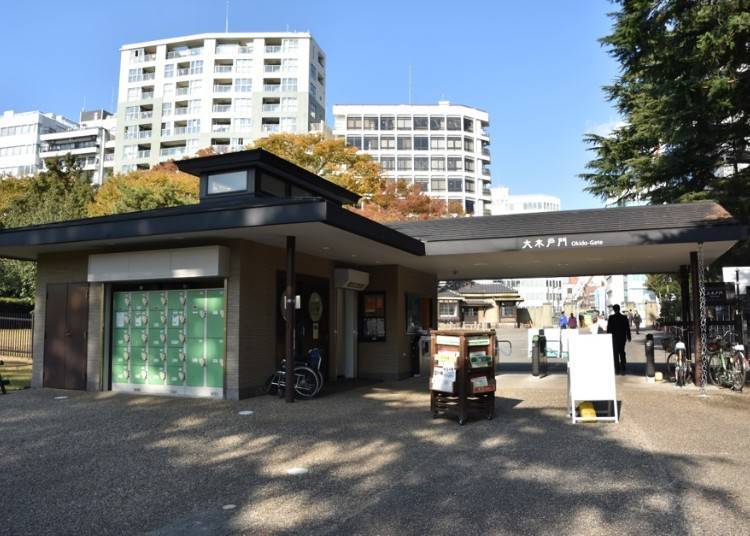
There is a parking lot next to the Okido Gate, which makes it convenient for those going by car. There is a large greenhouse near the entrance.
- By train: Take the Tokyo Metro Marunouchi Line and get off at Shinjuku Gyoen-mae Station. Go out through Exit 2 and walk for 5 minutes to reach the garden.
- By bus (option 1): Board the Toei Bus Shina 97 going to Shinagawa Garage at Shinjuku Station West Exit, and get off at the Shinjuku 1-chome bus stop.
- By bus (option 2): Board the Toei Bus Haya 81 going to Sodai Seimon at Shibuya Station East Exit, and get off at the Yotsuya 4-chome bus stop.
Getting to the Sendagaya Entrance
The Sendagaya Gate is the least used of the three entrances, however, if you enter here, the large lawn area known as Children's Square is nearby.
- Using the JR Sobu Line: Get off at Sendagaya Station and walk for 5 minutes.
- Using the Toei Subway Oedo Line: Get off at Kokuritsu-Kyogijo Station, take Exit A5, and walk for 5 minutes.
- By bus (option 1): Board the Kuro 77 Toei Bus going to Meguro Station at Sendagaya Station, and get off at Sendagaya Ekimae bus stop.
- By bus (option 2): Board the Haya 81 Toei Bus going to Sodai Seimon at the East Exit of Shibuya Station, and get off at Sendagaya Ekimae bus stop.
What to see in Shinjuku Gyoen
Shinjuku Gyoen is 58.3 hectares in area and 3.5 square kilometers in circumference, so it may be difficult to choose where to go first.
Here are some of the selected spots that you should definitely visit when you come to Shinjuku Gyoen.
A Japanese garden where you can enjoy the uniqueness of Japan
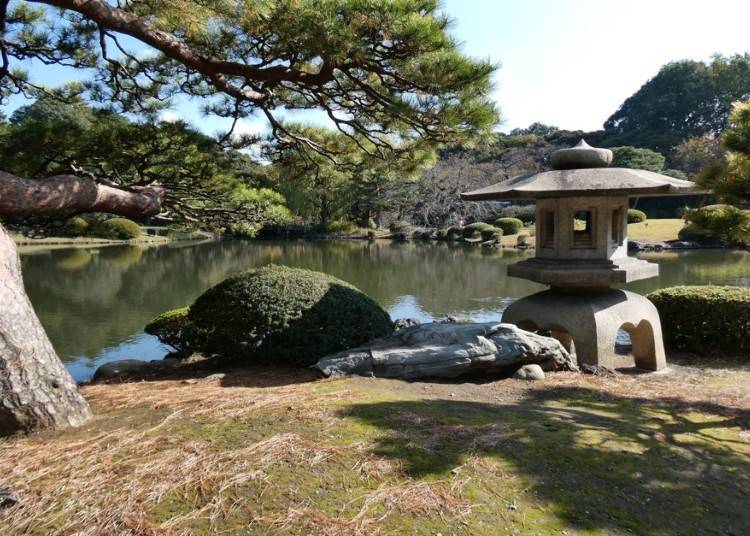
When you come to Shinjuku Gyoen, stop by the Japanese garden. This is a spacious area that is very Japanese in style. Japanese and many foreign tourists visit here, taking lots of photos and enjoying the garden.
This Japanese garden perfectly conveys the image and culture of Japan. It was designed to go along with the flow of the pond.
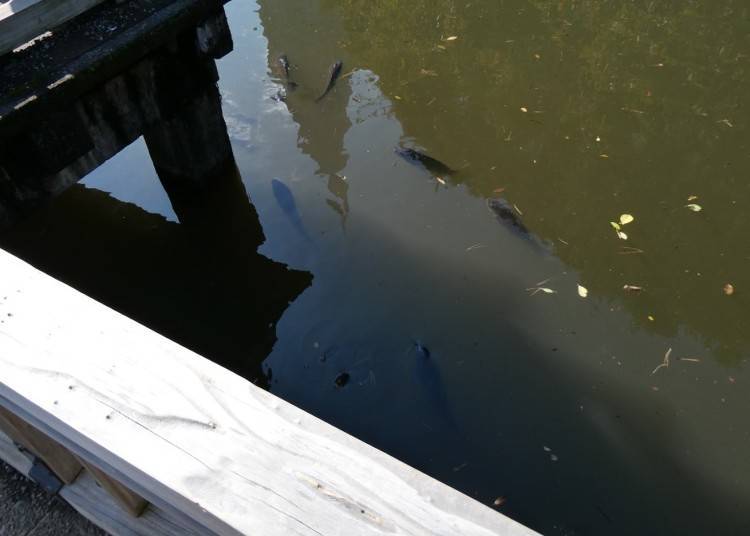
There are many carp swimming in the pond of the Japanese garden. Sometimes you can even see turtles sitting on rocks.
The Kyu Goryo-tei (Taiwan Pavilion), a historical structure you can visit
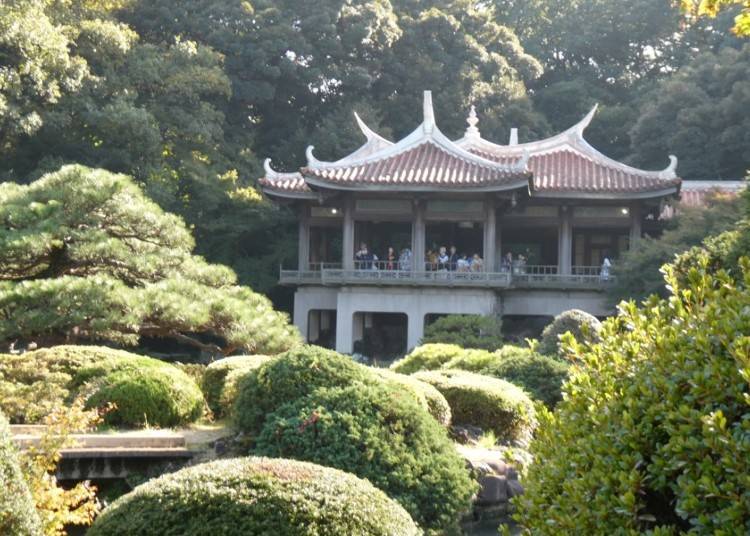
The Kyu Goryo-tei (Taiwan Pavilion) is one of only a few authentic Chinese-style structures in Japan. The roof style, color, and interior faithfully convey the Chinese style.
There is a peculiar tranquility in the Kyu Goryo-tei, and it has a relaxed atmosphere different from other places in the Japanese garden.
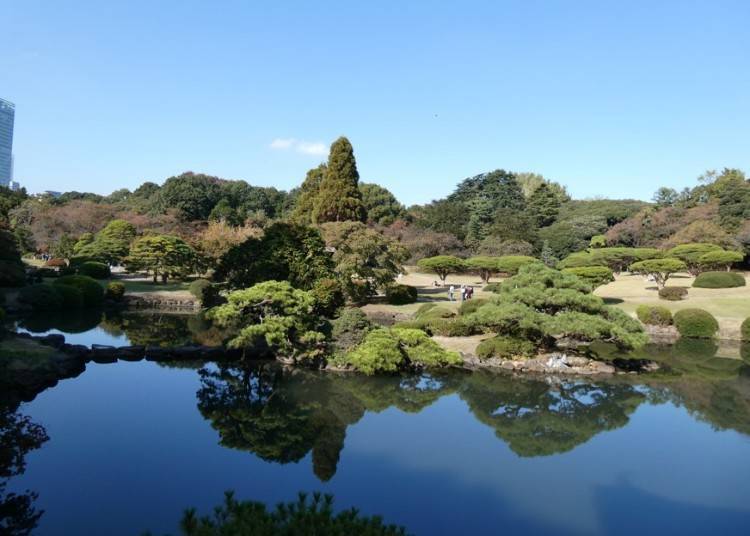
You can view the pond from inside the Kyu Goryo-tei. The reflection of the trees and sky on the pond is so pretty that one never tires of looking at them.
Western-style gardens
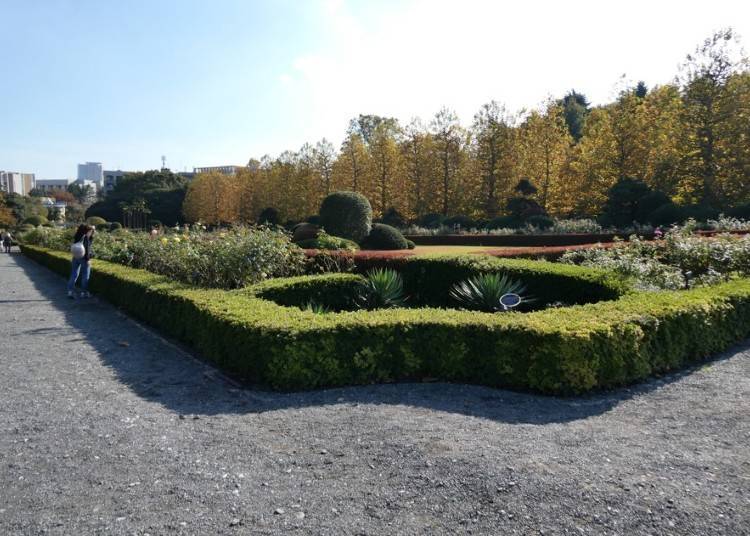
The formal garden is beautifully symmetrical. In the center, the flower beds contain about 500 roses of 110 different varieties, and on the left and right, extending for about 200 meters is a row of sycamore trees. In this garden, you can enjoy European-style scenery, which differs from Japanese and Asian-style scenery.
It takes about 5 to 10 minutes to walk from the Japanese garden to the formal garden. The transition from the Japanese Garden to the Formal Garden is made effortlessly and is one of the masterpieces of Shinjuku Gyoen.
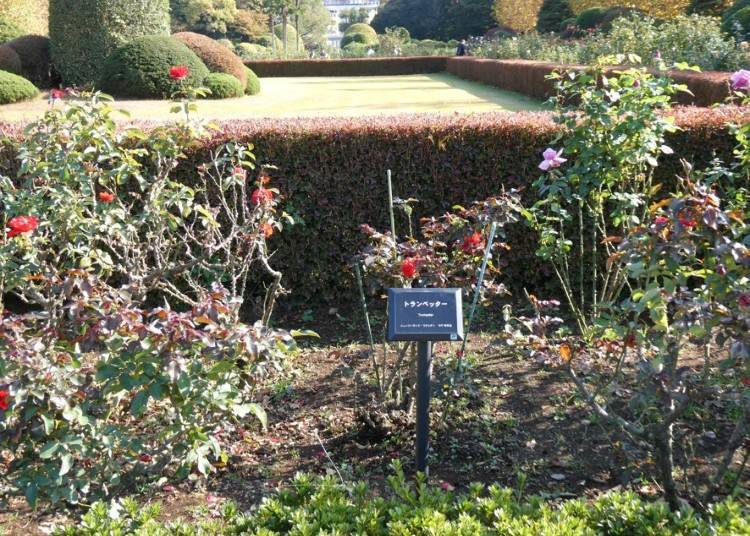
Rose flowerbeds. We could see autumn roses when we made this report in the middle of November. The best time for viewing autumn roses is from the middle of October to the end of November.
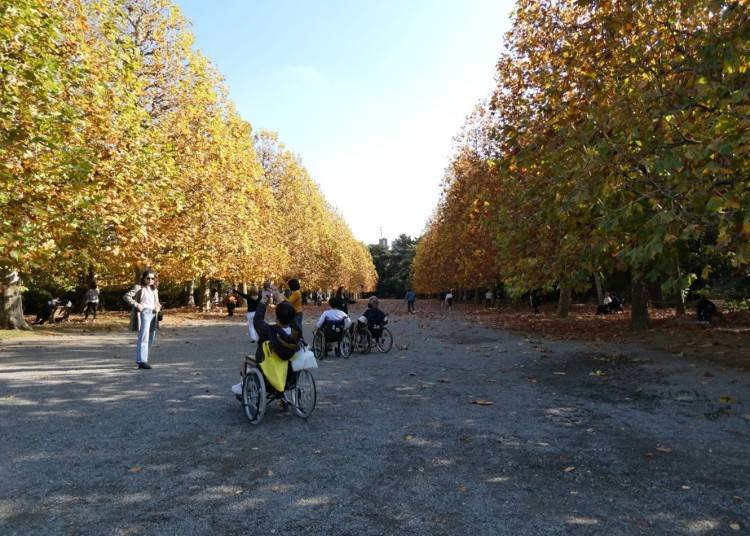
Among the many spots in Shinjuku Gyoen, the sycamore trees are magnificent, evoking a romantic feeling like one in a movie scene. People of all ages come to enjoy and photograph the autumn leaves.
Landscape garden with impressive wide lawn with buildings in the background
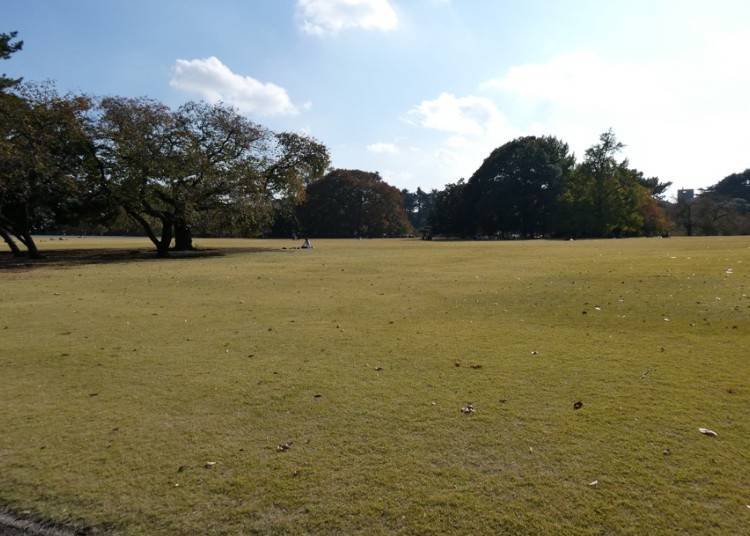
The landscape garden is a garden characterized by open grass and giant trees. Between the towering tulip trees, the symbolic tree of Shinjuku Gyoen, and skyscrapers can be seen.
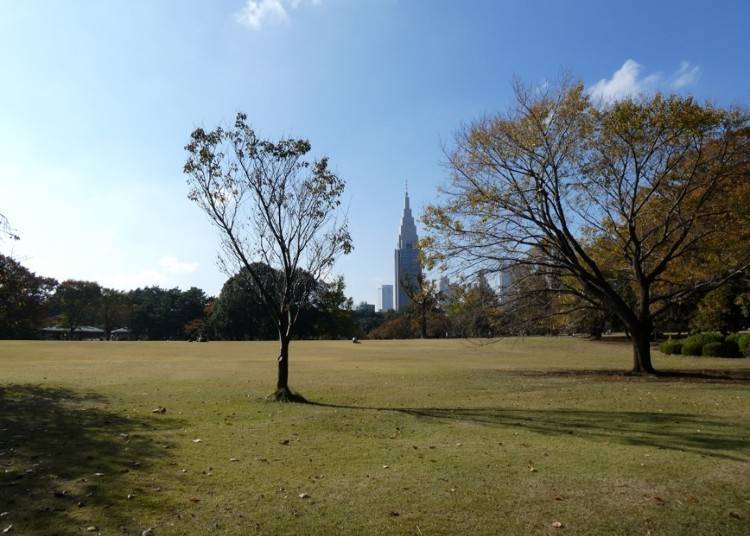
On the lawn you can see people lying on the grass and families enjoying picnics. Isn't it a really pleasant place on a sunny day?
Large greenhouse where various kinds of plants can be seen
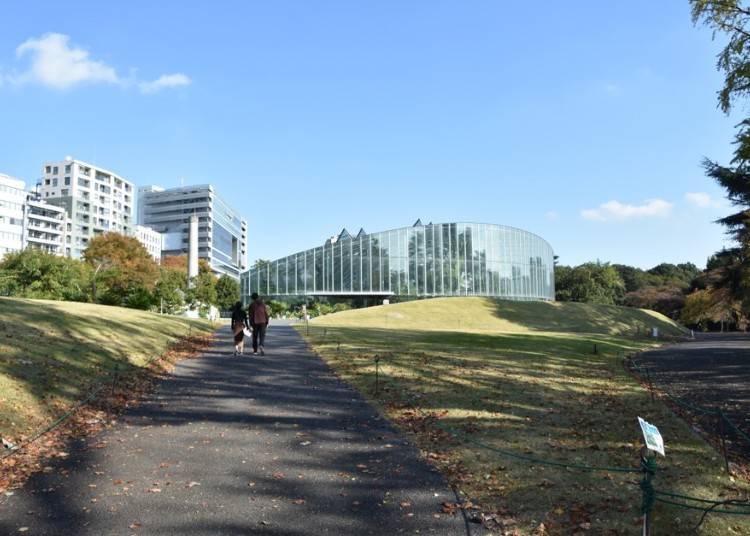
There is a large greenhouse that reopened in 2012 near the Okido Gate.
You can see tropical plants from all over the world, Japanese plants from the Ogasawara Islands and Okinawa, and you can also see western orchids since Shinjuku Gyoen is the birthplace of full-fledged orchid cultivation in Japan.
The large greenhouse is warm even in winter, so if you come to Shinjuku Gyoen in winter, this is a good place to get warm.
Former Western-style Rest House is designated an important cultural property
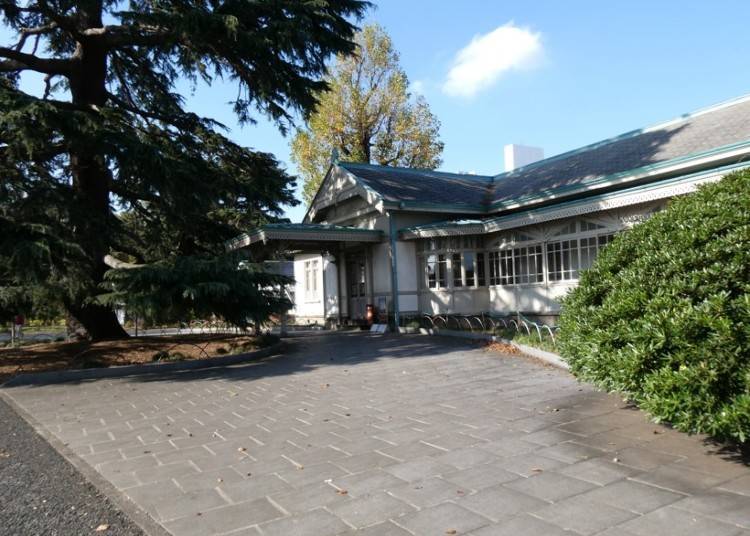
The former Western-style Rest House, a facility designated as an important cultural property, is near the large greenhouse. Originally it was built as a place for the Imperial Family to rest when they came to view the plants in the greenhouse.
Later, after it was used as a rest house for the Imperial Family, it was turned into a clubhouse for golf and tennis, and until 1994 it functioned as an administrative office. It underwent renovation in 2000, which was completed in 2001. It has been designated as an Important Cultural Property as a historic and culturally valuable building.
Open to the public on Saturdays, Sundays, and holidays every month. Please check the Shinjuku Gyoen website of the Ministry of the Environment for notices and hours. Please note that it is forbidden to take photos inside the Rest House.
Shinjuku Gyoen restaurants, cafes and tea rooms
There are places and restaurants where you can take a break in Shinjuku Gyoen. These are good places to rest when walking about the expansive Shinjuku Gyoen.
Enjoy lunch at the Eco House Restaurant Yurinoki

The Shinjuku Gate is closest to the Eco House Restaurant Yurinoki. It is located in the landscape garden. The menu offers dishes made with ingredients related to Shinjuku Gyoen. The "Food Information Corner" introduces helpful information for eco-conscious living, such as the history of vegetables and fruits and how to enjoy them each season.

A recommended dish is the Sika venison curry rice (with Naito pepper). You can enjoy a curry made with Sika venison, a game deer meat of Hokkaido, together with vegetables related to Shinjuku Gyoen. Venison is rich in iron and minerals, low in calories, low in fat, and high in protein.
Naito pepper was grown in Naito Shinjuku and is said to have created a huge boom during the Edo period. There are not many opportunities to eat venison, such as Sika venison. Why not try it when visiting Shinjuku Gyoen?

Naito pepper crepe can also be purchased at the shop outside the restaurant.
Tea house Rakuu-tei, where you can enjoy matcha

Tea house Rakuu-tei is a tea room located in a grove of plum trees in the Japanese garden. It features a magnificent Japanese-style building and garden and is a spot where you can feel the Japanese soul known as wabi-sabi. At the tea room, you can enjoy matcha with seasonal Japanese sweets for 700 yen.
Open: 10:00 a.m. ~ 5:00 p.m. It is also possible to rent the tea room if you request.
Cafe Hananoki, inside the Information Center

Cafe Hananoki is a cafeteria located in the Information Center next to the entrance of the Shinjuku Gate. There are snacks, such as ice cream, and light meals, such as curries, so this is also a good place for lunch.
Setting for the animated film “The Garden of Words”
Shinjuku Gyoen was also the setting for the animated film “The Garden of Words.” This work was also done into a huge hit movie, “Your Name”, directed by Makoto Shinkai; it is noted for its beauty. It has become popular among fans of these works to make pilgrimages to Shinjuku Gyoen, which was the setting for the film.
Although various places in Shinjuku Gyoen are depicted in The Garden of Words, the one that appears most often in the work is the arbor near the Kyu Goryo-tei (Taiwan Pavilion). It is where the main character Takao, a high school student, and the heroine, Yukino, exchange words.
There is a scene in the movie where they drink beer, but please note that bringing alcoholic beverages or drinking them in Shinjuku Gyoen Garden is prohibited.
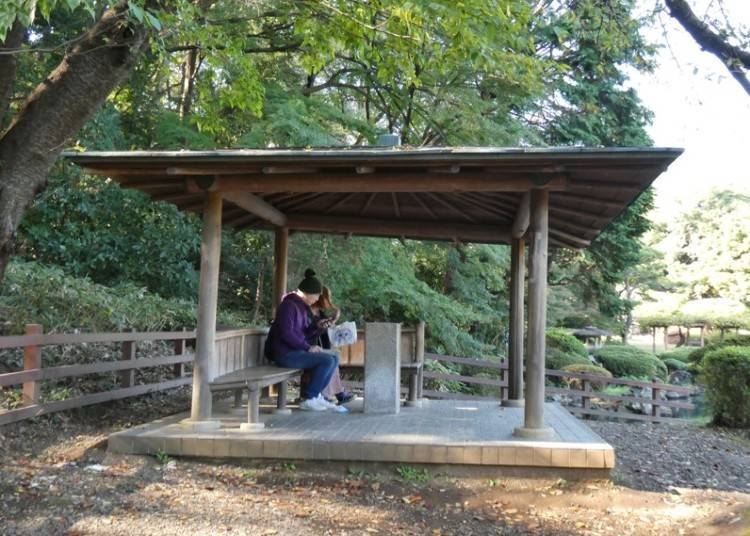
Next is the wisteria trellis, which was used as a key visual in the Garden of Words. You need to be careful because it is so unobtrusive that you can overlook it if you are not careful.
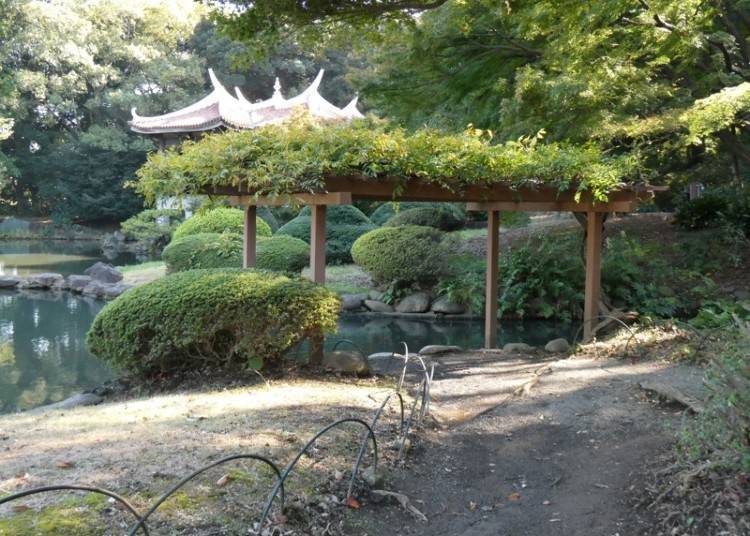
The arbor and wisteria trellis are particularly popular spots and are widely recognized as "holy places" by fans. Fans of The Garden of Words will particularly enjoy visiting here.
There are many things to see in Shinjuku Gyoen; so many in fact, that you would not become bored even after a full day. If you have come to Tokyo on a trip but have tired of the hustle and bustle of the city, or if you want to soothe away the fatigue of everyday life, then you will certainly enjoy a visit here. You will feel as if your spirit has been refreshed.
-
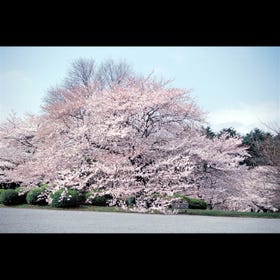
-
Address
11 Naito-cho, Shinjuku-ku, Tokyo, 160-0014
View Map -
Nearest Station
Shinjuku-Gyoemmae Station (Tokyo Metro Marunouchi Line)
5 minutes on foot
- Phone Number 03-3350-0151
-
Address
11 Naito-cho, Shinjuku-ku, Tokyo, 160-0014
*Prices and options mentioned are subject to change.
*Unless stated otherwise, all prices include tax.
Limited time offer: 10% discount coupons available now!
-

Pop Culture Paradise: Find All Your Favorite Characters at Sunshine City in Ikebukuro
-

We eat fugu pufferfish semen at a Japanese restaurant in Tokyo
-
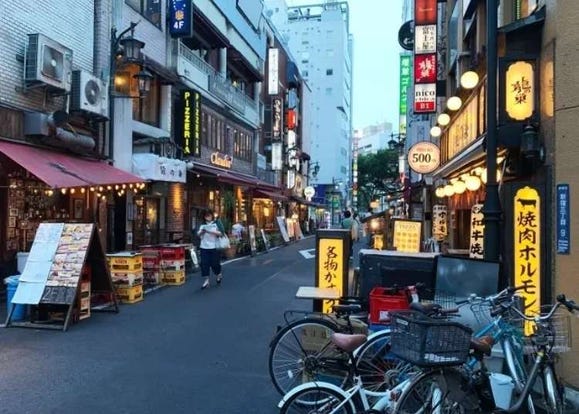
Japanese restaurant chain causes a stir with foreigners online, but is it any good?
-
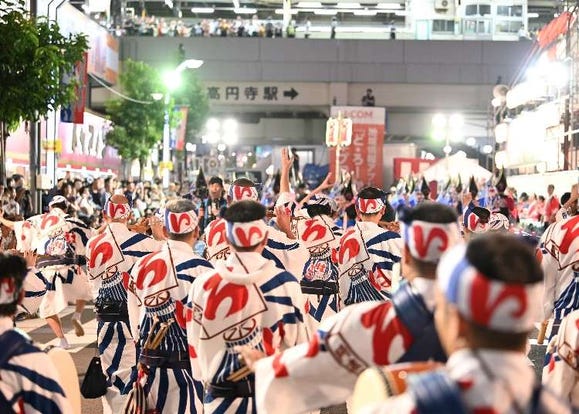
Things to Do in Tokyo in August 2023: Your Guide to Events, Summer Festivals, and Must-See Attractions
-

Discover the Beauty of Tokyo's Ueno Park: A Seasonal Flower Adventure With Cherry Blossoms, Lotus Blooms, and More
-
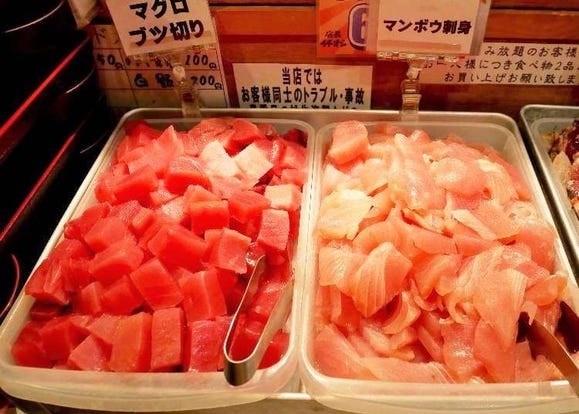
Numazuko Kaisho in Ueno: Good Quality, All-You-Can-Eat Seafood for Just US$12!?
-

Traveling around Tokyo: 10 Things You Didn't Know About Ueno Park!
-

Getting From Tokyo Narita Airport (NRT) to Tokyo: Complete Guide
- #best ramen tokyo
- #what to buy in ameyoko
- #what to bring to japan
- #new years in tokyo
- #best izakaya shinjuku
- #things to do tokyo
- #japanese nail trends
- #what to do in odaiba
- #onsen tattoo friendly tokyo
- #daiso
- #best sushi ginza
- #japanese convenience store snacks
- #best yakiniku shibuya
- #japanese fashion culture
- #best japanese soft drinks
